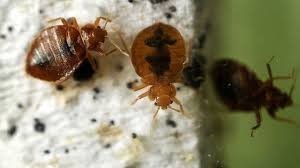
Where Do Bed Bug Come From
The common bed bug, Cimex lectularius, is a wingless insect, oval in shape, 4 to 5 mm long when fully grown, and are fast runners. They feed on human blood. They are rust brown in color and change to a deeper red brown following a blood meal.
Where do they come from originally?
That is a really good question. Where do bed bugs come from and how do I know if I have them.
In case you doubt the presence of bed bugs in the house, search for the dead skin of the bugs. Using this trick can help you find dead bed bugs if they ever existed in a house.
Bed bugs were thought to have come from Asia and Africa because they love the tropical climates. But, they have also been found in Europe and now, North America and South America, and even Australia.
It doesn’t really matter in a geographic sense where they come from. That’s because they are incredible hitchhikers and their small size and hardiness make it easy for them to travel from place to place, picking up blood nourishment along the way from travelers and soldiers.
Bedbugs were originally bat bugs. Their ancestors lived in caves, on bats (where most of their kin still live), and when our ancestors moved into caves, they jumped down onto us. A few found us where we slept. Those that did found it easier to live off our blood and it was easier to obtain. These bugs have been found fossilized, dating back further than 3,500 years, and have been found at archaeological sites.
During that age, the bugs were used as a potion to try to cure common ailments. Bed Bugs were burned by the Romans and Greeks to make leeches release their hold. To cure snakebite, Egyptians would drink them. They thrived due to the formation of villages and then cities. Civilization grew and the bugs multiplied and spread all throughout Asia and Europe. England first reported the bugs in 1583.
Shortly thereafter, they arrived in the Americas, stowing away with the European explorers and the settlers. The early colonists brought the bugs with them to the Americas in the 1700‘s. In the earlier part of the 18th century, colonial writings document severe problems with them in Canada and the English colonies. In the 1800s, they were abundant in North America following the arrival of the European settlers.
By the middle of the 1800s, the poor were plagued as well as the rich. These were overcrowded areas that had low cleanliness standards. The wealthier households that had excess domestic help discovered that vigorous housekeeping assisted in eliminating the pests.
When they moved onto us, many things would have had to change for these bat bugs. The platelets in our blood, for example, are wider than those of bats, and so the mouthparts of the bedbugs had to widen so that they wouldn’t clog up with blood. Their mouthparts changed in length, too, because of the thickness of our skin, a thickness through which their mandibles must meander to find blood vessels.
Their activity patterns changed, too. Bat bugs feed during the day, when the bats are sleeping. Bedbugs, well, they had to feed at night, when we were sleeping. Bedbugs changed so much in moving onto us, in fact, that now they are stuck. They can’t easily go back and why would they want to? They ride us wherever we might lead them, which, it turns out, is all around the world.

The five juvenile nymph stages are miniature versions of the adults in appearance. Each nymph stage requires at least one blood meal to molt to the next stage and it takes 5 to 10 minutes for a complete meal. The entire development to adult takes 6 to 8 weeks, and adults live on average for 6 to 12 months.
After mating once, each female lays 1 to 5 eggs per day throughout her life span. The 1mm cream-colored eggs are cemented on rough surfaces of hiding places and will hatch within 10 days at room temperature, longer when cooler.
Bed bugs shelter in a variety of dark locations, close to where people sleep. Typical places are under mattresses, floorboards, paintings and carpets, behind skirting, in various cracks and crevices of walls, within bed frames and other furniture, and behind loose wallpaper.
Bed bugs are one of the great travelers of the world and are readily transported via luggage, clothing, bedding, and furniture. As such, they have a worldwide distribution.
Getting Rid Of Them
Over the years, there have been many formulas claiming they could assist in controlling infestations. If these formulas were used today, it could result in being jailed. If you suspect an infestation of bed bugs then there are some effective DIY solutions but, you must do the applications right.
You will carefully inspect all possible hiding places within infested and adjoining rooms. Once you identify all likely hiding places, then you will use an approved insecticide, which will have some residual activity. The synthetic pyrethroids, notably permethrin, are the main chemicals of choice for control. You can buy these chemicals yourself. Good housekeeping practices and a reduction in possible harbourages such as cracks and crevices will discourage repeat infestations.
As bed bugs are cryptic in their habits, complete control is often difficult to achieve with the first treatment. This is especially so with heavy infestations and a repeat treatment evaluation should be performed.
The residence of bed bugs is not confined only to the bed, but also in your clothes, your storage spaces, the places you visit like a mall or a movie theatre etc. Also, the occurrence of bed bugs has nothing to do with your bank accounts! You are human, and have blood?
Be prepared to be infested by these bugs at any time. The moment these bugs get hitched to you, and once they feed on you, they won’t be staying there for long, but definitely, you would be making an easy entry for those bugs inside your house. Once they feed on you, they will be searching for a place to lay their eggs.
Now for those people who don’t travel much, and reside in a pesticide filled family house, your experience with these bed bugs might have been rare. The reason behind this is that the presence of these bugs usually takes place where human population turnover has been high. A place that is visited by several people, is susceptible to be infested by these critters.

So, it doesn’t really matter where bed bugs come from, we just have to make sure we don’t pick them up or if you already have them, How To Get Rid Of Them.
Your home provides a good residence for these tiny creatures, therefore it becomes essential to prevent rather than eradicate. We must be very careful when we go on vacation and not pick up the blood-sucking hitchhikers and bring them home with us.






